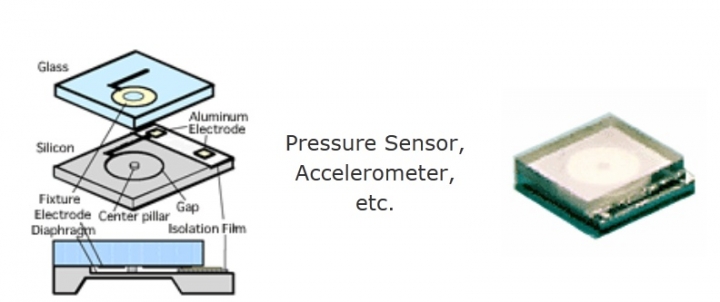Omron Develops CMOS-MEMS Absolute Pressure Sensor

Japanese form, Omron Corporation has developed an absolute pressure sensor capable of accurately detecting 50cm altitudinal variations. The product will be released in January 2013.
The absolute pressure sensor, which measures air pressure relative to a vacuum, fully exploits the latest MEMS technology. Despite its sub-miniature dimensions, Omron says its meter is one of the world's most accurate and power efficient.
Through the integration of CMOS circuits and MEMS sensors, Omron has created an absolute pressure sensor measuring a compact 3.8mm à— 3.8mm à— 0.92mm, making it suitable for installation in small mobile devices and other compact hardware. The actual chip size is 1.9mm à— 1.9mm à— 0.5mm. The sensor has a detection range of 300hPa to 1100hPa and is able to detect the relative difference of approximately 6pa in air pressure that exists between 50cm variations in altitude.
With a low current consumption of 0.5µA to 9.5µA, it is suitable for use in battery-operated devices (current consumption levels are dependent on measurement conditions and operating modes). A built-in temperature sensor can be used to adjust measurements to compensate for air pressure fluctuation due to changes in air temperature. With I2C output, the sensor is also serial communications compatible.
The sensor's power efficiency makes it well-suited for
use in smartphones. It is also suitable for use in activity monitors, which measure
the number of steps taken when walking or running and the intensity of bodily
movement during other energy-burning activities. Installing the pressure sensors in activity monitors
will make it possible to take into account the altitudinal variation involved
in one's daily activities and exercise such as climbing up and down stairs or while
doing the housework, for example.
In car navigation systems, the sensors can be used to
provide accurate navigation guidance inside multistory car parks and also
enable such systems to distinguish between elevated roadways and the
ground-level roads beneath them.
Another application is in building security, to detect fluctuations in air pressure due to, for example, a door opening or a window breaking.
Omron also plans to release integrated CMOS-MEMS wafers to make it possible to install other sensors on the same board as the absolute pressure sensor.
1. How Omron's MEMS absolute pressure sensor measures air pressure
Omron's MEMS absolute pressure sensor employs piezoresistance technologies which the company has cultivated through long years of developmental work on digital blood pressure monitors. Piezoresistance technologies use the "piezoresistance effect" (the variation in resistivity of a resistive material when stress is applied to it), to convert pressure into an electrical signal. Omron's pressure sensor detects variation in atmospheric pressure relative to a vacuum chamber created inside the sensor chip with MEMS bonding technology. Absolute pressure measurements are obtained by detecting the difference in pressure between the vacuum and external atmospheric pressure.
2. Technological features
Thanks to the semiconductor circuit design technologies, CMOS process technologies, and MEMS technologies that Omron has cultivated over many years, the company has also been able to integrate pressure sensors, analogue amplifier circuits, digital processing circuits, non-volatile memory, etc. onto single chips. The company has also been able to simultaneously reduce chip size, increase chip functionality, and enhance chip noise immunity, and through the use of MEMS bonding technology, they have been able to create a large vacuum chamber inside the body of the sensor chip itself to maximise the sensor's input dynamic range, and thereby increase the sensor's sensitivity.
3. Altitudinal variation detection measurements
Accurate detection of altitudinal variations as small as 50cm is possible.
The firm will be exhibiting its new MEMS absolute pressure sensor at the Micromachine/MEMS ROBOTECH 2012 exhibition at Tokyo Big Sight from July 11 (Wed) to July 13 (Fri).
































